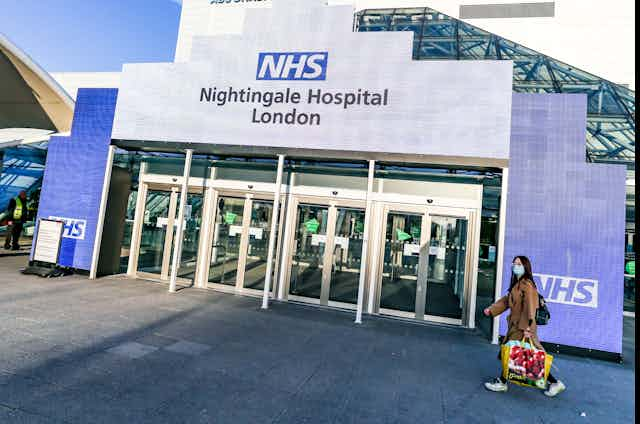The coronavirus pandemic has resulted in new thinking about how cities are best organised to meet our needs. Part of this has involved short-term changes in the use of urban space.
In England, some planning regulations have been relaxed to allow buildings to be repurposed in response to the crisis. In Italy, there are proposals to convert shipping containers to intensive care units.
Our research into the temporary use of land and buildings shows the ways in which short-term development is deployed during times of crisis. Temporary uses also offer the opportunity for more fundamental rethinking of urban space in the longer term.
Rapid response
Responding to COVID-19, temporary spaces are providing a way of quickly bolstering intensive care bed spaces as demand spirals. London’s Nightingale hospital, in the remodelled ExCel conference venue, is one of a number of international examples of temporary field hospitals.
Temporary use may also help facilitate social distancing. Street closures in North America have been used to deter car use and increase space for pedestrians.
There are also more imaginative examples. In Bristol, residents have created an informal runners’ lane to ensure safe passage between pedestrians and joggers in accordance with UK social distancing rules.
In Bogotá, curbs on car use have liberated space for the temporary expansion of the city’s network of cycle paths, helping, in turn, to reduce overcrowding on public transport. Likewise, Germany has introduced extensions to pavement and bike lanes.
These measures are practical responses, reflecting changed priorities regarding urban infrastructure. But the history of temporary urbanism in response to crises shows that short-term repurposing can address other needs.
After the 2011 earthquake in Christchurch, New Zealand, a number of examples of tactical, temporary re-use of urban space emerged. Some – from an urban living room featuring a book exchange inside a recycled fridge to dance spaces on disused land with music from a converted washing machine – were about maintaining community spirit in the face of adversity.
Other temporary uses have responded to economic crises. In western cities after the global financial crisis, temporary re-use reflected landowners’ desire to maintain income and the wish of political leaders to protect local economies. This logic informed the establishment of temporary businesses known as pop-up shops or the re-use of shipping containers for everything from urban agriculture to shopping malls.
These examples show the dynamic role temporary use of land and buildings can play in keeping cities functioning in the face of adversity.
In the current health crisis, there is scope for temporary solutions again to prove vital. Equally, these short-term expedient measures could have longer-term benefits, extending beyond the current crisis.
The reduction of traffic, extension of footpaths and installation of temporary cycle ways promotes new opportunities for play, health and sustainable mobility. As an example, play streets could radically alter urban childhoods for the better.
More immediately, these measures would provide an alternative lifeline for communities if parks and green spaces were to eventually close.
Learning from the past
Lessons from the 2007/08 financial crisis suggest that allowing innovative adaptations to continue when something approaching normality resumes will be a challenge.
In the aftermath of the global financial crisis, the number of innovative temporary uses doubled in major English cities. But when the wider economy recovered, many innovative temporary uses – including urban farms, beach bars and pop-up cinemas – were sacrificed in favour of business-as-usual development. Those that remained were sometimes co-opted by established corporate interests, often diluting their radical purpose.

Rather than encouraging new innovative or progressive uses of space, the deployment of mobile temporary use frequently served as a means to incentivise development by encouraging speculative private investment in previously unattractive locations.
With COVID-19, temporary uses might prove to be more lasting. This is partly because the scale of the health crisis requires adaptation beyond a few landmark developments. It may also require at least some element of social distancing to be maintained for a protracted period. Safe movement in and around cities may require temporary design solutions to become more permanent, or to be deployed again if this or a similar health crisis resurfaces.
In the longer term, the shape of urban living after coronavirus, and the extent to which it is different, remains uncertain. But previous crises suggest that at least some of the temporary uses currently emerging may well endure into the future.

